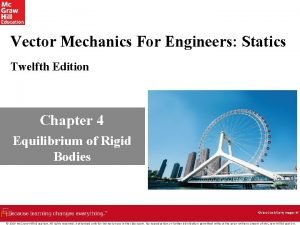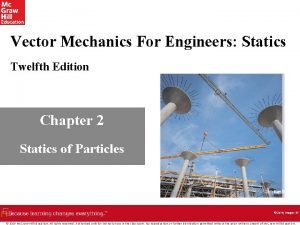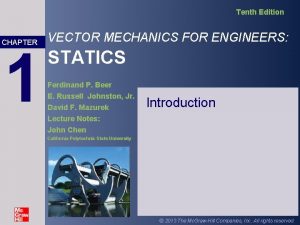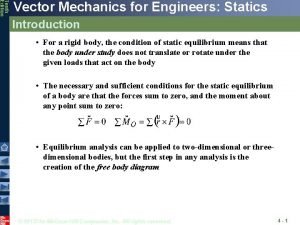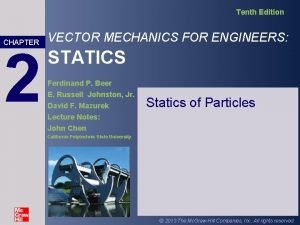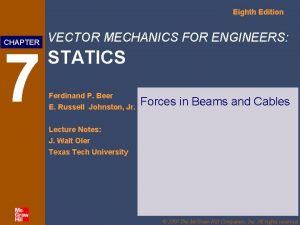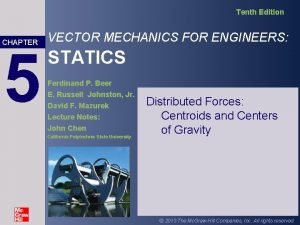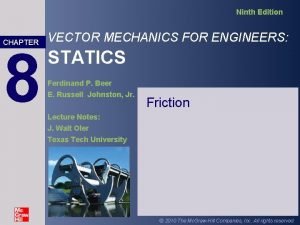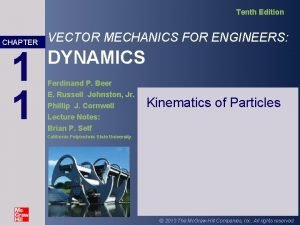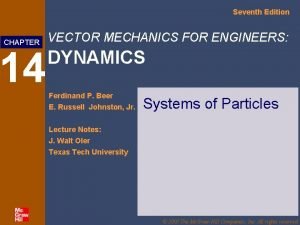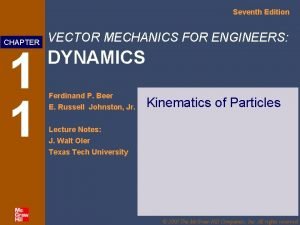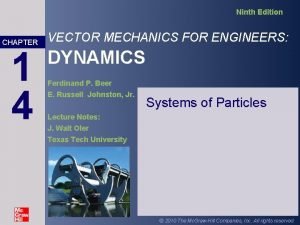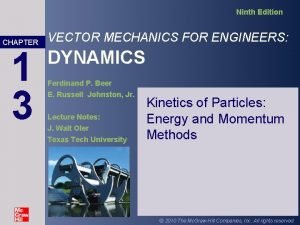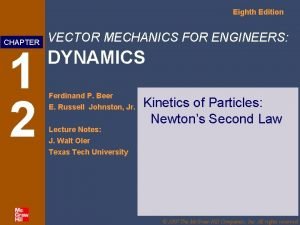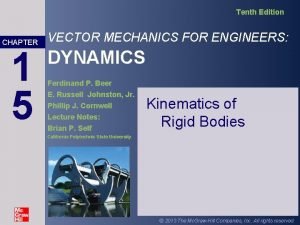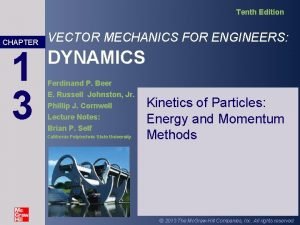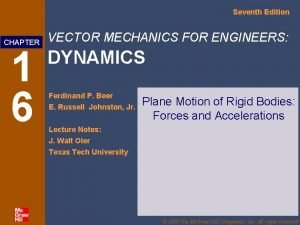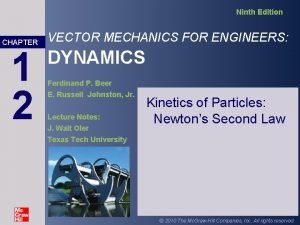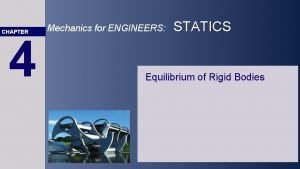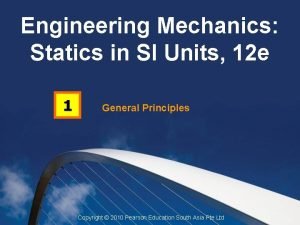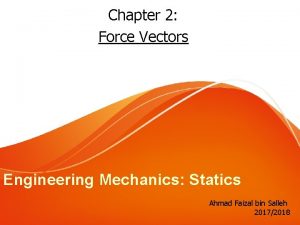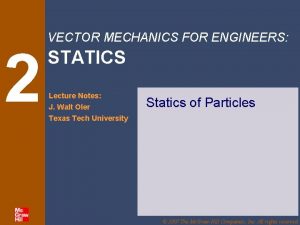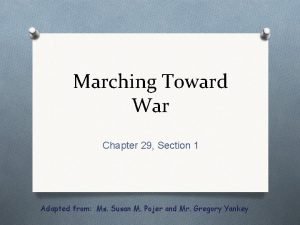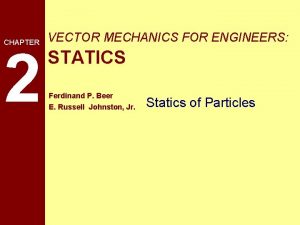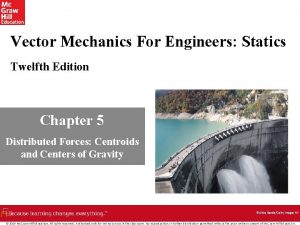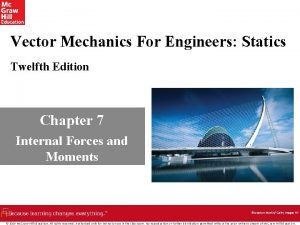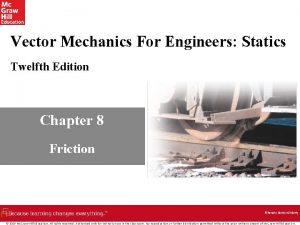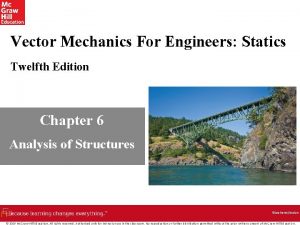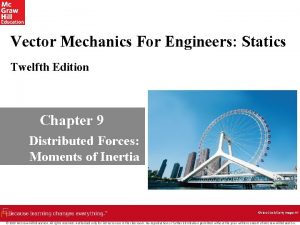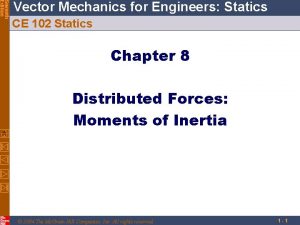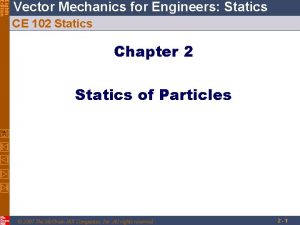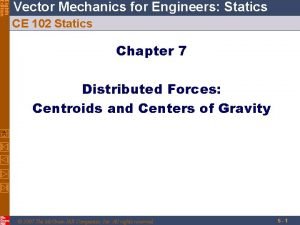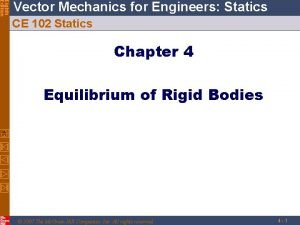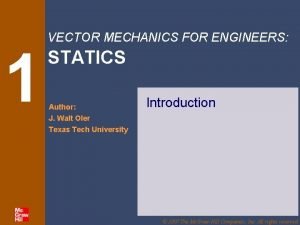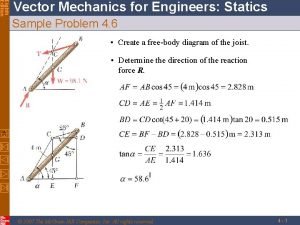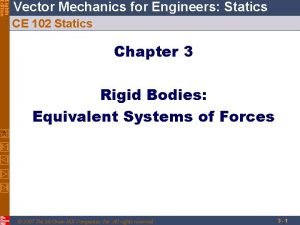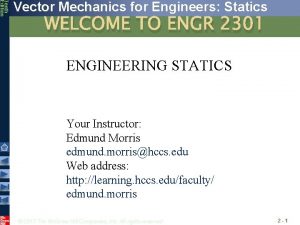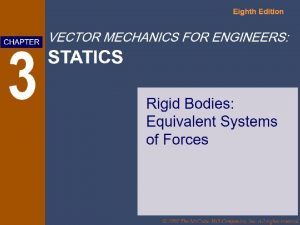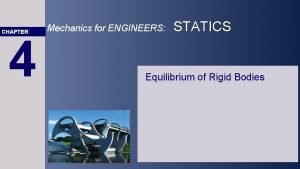CHAPTER 3 VECTOR MECHANICS FOR ENGINEERS STATICS Ferdinand





























![Vector Mechanics for Engineers: Statics Sample Problem 3. 12 [cont. ] 3 - 30 Vector Mechanics for Engineers: Statics Sample Problem 3. 12 [cont. ] 3 - 30](https://slidetodoc.com/presentation_image_h2/eef744c4503fdc0fad2621315f7cbe7c/image-30.jpg)
- Slides: 30

CHAPTER 3 VECTOR MECHANICS FOR ENGINEERS: STATICS Ferdinand P. Beer E. Russell Johnston, Jr. Rigid Bodies: Equivalent Systems of Forces

Vector Mechanics for Engineers: Statics Contents Introduction Moment of a Force About a Given Axis External and Internal Forces Sample Problem 3. 5 Principle of Transmissibility: Equivalent Forces Moment of a Couple Vector Products of Two Vectors Couples Can Be Represented By Vectors Moment of a Force About a Point Resolution of a Force Into a Force at O and a Couple Varigon’s Theorem Addition of Couples Rectangular Components of the Moment of Sample Problem 3. 6 a Force System of Forces: Reduction to a Force and a Couple Sample Problem 3. 1 Scalar Product of Two Vectors Further Reduction of a System of Forces Scalar Product of Two Vectors: Applications Sample Problem 3. 8 Sample Problem 3. 10 Mixed Triple Product of Three Vectors 3 -2

Vector Mechanics for Engineers: Statics Introduction • Treatment of a body as a single particle is not always possible. In general, the size of the body and the specific points of application of the forces must be considered. • Most bodies in elementary mechanics are assumed to be rigid, i. e. , the actual deformations are small and do not affect the conditions of equilibrium or motion of the body. • Current chapter describes the effect of forces exerted on a rigid body and how to replace a given system of forces with a simpler equivalent system. - moment of a force about a point - moment of a force about an axis - moment due to a couple • Any system of forces acting on a rigid body can be replaced by an equivalent system consisting of one force acting at a given point and one couple. 3 -3

Vector Mechanics for Engineers: Statics External and Internal Forces • Forces acting on rigid bodies are divided into two groups: - External forces - Internal forces • External forces are shown in a free -body diagram. • If unopposed, each external force can impart a motion of translation or rotation, or both. 3 -4

Vector Mechanics for Engineers: Statics Principle of Transmissibility: Equivalent Forces • Principle of Transmissibility Conditions of equilibrium or motion are not affected by transmitting a force along its line of action. NOTE: F and F’ are equivalent forces. • Moving the point of application of the force F to the rear bumper does not affect the motion or the other forces acting on the truck. • Principle of transmissibility may not always apply in determining internal forces and deformations. 3 -5

Vector Mechanics for Engineers: Statics Vector Product of Two Vectors • Concept of the moment of a force about a point is more easily understood through applications of the vector product or cross product. • Vector product of two vectors P and Q is defined as the vector V which satisfies the following conditions: 1. Line of action of V is perpendicular to plane containing P and Q. 2. Magnitude of V is 3. Direction of V is obtained from the right-hand rule. • Vector products: - are not commutative, - are distributive, - are not associative, 3 -6

Vector Mechanics for Engineers: Statics Vector Products: Rectangular Components • Vector products of Cartesian unit vectors, • Vector products in terms of rectangular coordinates 3 -7

Vector Mechanics for Engineers: Statics Moment of a Force About a Point • A force vector is defined by its magnitude and direction. Its effect on the rigid body also depends on its point of application. • The moment of F about O is defined as • The moment vector MO is perpendicular to the plane containing O and the force F. • Magnitude of MO measures the tendency of the force to cause rotation of the body about an axis along MO. The sense of the moment may be determined by the right-hand rule. • Any force F’ that has the same magnitude and direction as F, is equivalent if it also has the same line of action and therefore, produces the same moment. 3 -8

Vector Mechanics for Engineers: Statics Moment of a Force About a Point • Two-dimensional structures have length and breadth but negligible depth and are subjected to forces contained in the plane of the structure. • The plane of the structure contains the point O and the force F. MO, the moment of the force about O is perpendicular to the plane. • If the force tends to rotate the structure clockwise, the sense of the moment vector is out of into the plane of the structure and the magnitude of the moment is positive negative. • If the force tends to rotate the structure counterclockwise, the sense of the moment vector is out of into the plane of the structure and the magnitude of the moment is negative positive. 3 -9

Vector Mechanics for Engineers: Statics Varignon’s Theorem • The moment about a given point O of the resultant of several concurrent forces is equal to the sum of the moments of the various moments about the same point O. • Varigon’s Theorem makes it possible to replace the direct determination of the moment of a force F by the moments of two or more component forces of F. 3 - 10

Vector Mechanics for Engineers: Statics Rectangular Components of the Moment of a Force The moment of F about O, 3 - 11

Vector Mechanics for Engineers: Statics Rectangular Components of the Moment of a Force [cont. ] 3 - 12

Vector Mechanics for Engineers: Statics Rectangular Components of the Moment of a Force The moment of F about B, 3 - 13

Vector Mechanics for Engineers: Statics Rectangular Components of the Moment of a Force For two-dimensional structures, 3 - 14

Vector Mechanics for Engineers: Statics Sample Problem 3. 1 A 100 -N vertical force is applied to the end of a lever which is attached to a shaft at O. Determine: a) moment about O, b) horizontal force at A which creates the same moment, c) smallest force at A which produces the same moment, d) location for a 240 -N vertical force to produce the same moment, e) whether any of the forces from b, c, and d is equivalent to the original force. 3 - 15

Vector Mechanics for Engineers: Statics Sample Problem 3. 1 a) Moment about O is equal to the product of the force and the perpendicular distance between the line of action of the force and O. Since the force tends to rotate the lever clockwise, the moment vector is into the plane of the paper. 3 - 16

Vector Mechanics for Engineers: Statics Sample Problem 3. 1 b) Horizontal force at A that produces the same moment, 3 - 17

Vector Mechanics for Engineers: Statics Sample Problem 3. 1 c) The smallest force at A to produce the same moment occurs when the perpendicular distance is a maximum or when F is perpendicular to OA. 3 - 18

Vector Mechanics for Engineers: Statics Sample Problem 3. 1 d) To determine the point of application of a 240 N force to produce the same moment, 3 - 19

Vector Mechanics for Engineers: Statics Sample Problem 3. 1 e) Although each of the forces in parts b), c), and d) produces the same moment as the 100 N force, none are of the same magnitude and sense, or on the same line of action. None of the forces is equivalent to the 100 N force. [57. 7 N] [50 N] 3 - 20

Vector Mechanics for Engineers: Statics Sample Problem 3. 2 3 - 21

Vector Mechanics for Engineers: Statics Sample Problem 3. 3 3 - 22

Vector Mechanics for Engineers: Statics Sample Problem 3. 4 SOLUTION: The moment MA of the force F exerted by the wire is obtained by evaluating the vector product, The rectangular plate is supported by the brackets at A and B and by a wire CD. Knowing that the tension in the wire is 200 N, determine the moment about A of the force exerted by the wire at C. 3 - 23

Vector Mechanics for Engineers: Statics Sample Problem 3. 4 SOLUTION: 3 - 24

Vector Mechanics for Engineers: Statics Scalar Product of Two Vectors • The scalar product or dot product between two vectors P and Q is defined as • Scalar products: - are commutative, - are distributive, - are not associative, • Scalar products with Cartesian unit components, 3 - 25

Vector Mechanics for Engineers: Statics Scalar Product of Two Vectors: Applications • Angle between two vectors: • Projection of a vector on a given axis: • For an axis defined by a unit vector: 3 - 26

Vector Mechanics for Engineers: Statics Mixed Triple Product of Three Vectors • Mixed triple product of three vectors, • The six mixed triple products formed from S, P, and Q have equal magnitudes but not the same sign, • Evaluating the mixed triple product, 3 - 27

Vector Mechanics for Engineers: Statics Moment of a Force About a Given Axis • Moment MO of a force F applied at the point A about a point O, • Scalar moment MOL about an axis OL is the projection of the moment vector MO onto the axis, • Moments of F about the coordinate axes, 3 - 28

Vector Mechanics for Engineers: Statics Moment of a Force About a Given Axis • Moment of a force about an arbitrary axis, • The result is independent of the point B along the given axis. 3 - 29
![Vector Mechanics for Engineers Statics Sample Problem 3 12 cont 3 30 Vector Mechanics for Engineers: Statics Sample Problem 3. 12 [cont. ] 3 - 30](https://slidetodoc.com/presentation_image_h2/eef744c4503fdc0fad2621315f7cbe7c/image-30.jpg)
Vector Mechanics for Engineers: Statics Sample Problem 3. 12 [cont. ] 3 - 30
 Static equilibrium
Static equilibrium Line of action of force
Line of action of force Vector mechanics for engineers: statics 10th edition
Vector mechanics for engineers: statics 10th edition Vector mechanics for engineers statics 10th edition
Vector mechanics for engineers statics 10th edition Vector mechanics for engineers statics 10th edition
Vector mechanics for engineers statics 10th edition Vector mechanics for engineers 10th edition
Vector mechanics for engineers 10th edition Vector mechanics for engineers chapter 7 solutions
Vector mechanics for engineers chapter 7 solutions Vector mechanics for engineers
Vector mechanics for engineers Vector mechanics for engineers
Vector mechanics for engineers Vector mechanics for engineers: dynamics
Vector mechanics for engineers: dynamics Vector mechanics for engineers: dynamics
Vector mechanics for engineers: dynamics Vector mechanics for engineers dynamics 12th
Vector mechanics for engineers dynamics 12th Vector mechanics for engineers: dynamics
Vector mechanics for engineers: dynamics Vector mechanics for engineers: dynamics
Vector mechanics for engineers: dynamics Vector mechanics for engineers: dynamics
Vector mechanics for engineers: dynamics At the instant shown the length of the boom ab
At the instant shown the length of the boom ab Vector mechanics for engineers dynamics 12th
Vector mechanics for engineers dynamics 12th Vector mechanics for engineers dynamics 12th
Vector mechanics for engineers dynamics 12th Vector mechanics for engineers dynamics 12th
Vector mechanics for engineers dynamics 12th Engineering mechanics force system
Engineering mechanics force system Mechanics for engineers
Mechanics for engineers Engineering mechanics statics in si units
Engineering mechanics statics in si units Force vector engineering mechanics
Force vector engineering mechanics Statics
Statics Directed line segment
Directed line segment Vector unitario
Vector unitario Vector resolution examples
Vector resolution examples Position vector simple definition
Position vector simple definition Ferdinand magellan god gold glory
Ferdinand magellan god gold glory Ferdinand marcos contribution economy
Ferdinand marcos contribution economy Chapter 29 section 1 marching toward war
Chapter 29 section 1 marching toward war
